Why is it so
hard to change to a "from the garden" shopper instead of a "from the store"
shopper? From 'store bought' to 'home grown'? Habit. Ease. Familiarity. Assurance. You KNOW what to do with that food
from the store -- it tells you right on the box. It is the kind of food you and
the family are used to. Most likely it is what you grew up with. What people
will recognize at potlucks. That’s how you eat. But then there is that darned
little niggling voice reminding you (usually when you are busiest and not in the
mood for any voice, niggling or otherwise) of how much time and money you spent
on that garden. So you could save money on groceries. But you aren’t eating
the garden. The bugs are, the birds are, the rabbits are, even the neighbors . .
. but you aren’t. Not much anyway, not really. Oh sure, a tomato now and then,
a sprig of parsley, some lettuce to pile on the plate to prove you are a
gardener. Maybe a handful of green beans. But to really EAT from the garden? Get
most of a meal from the garden? Who has the time? Or the energy? So the guilt
sets in. You want to, of course, but you can’t, because---and you start
listing off all the reasons.
It doesn’t have to be that way. First, don’t be so unreasonable with
yourself. Or expect so little. If you aren’t used to eating in season,
shopping from the ground on a daily basis, there’s no reason to expect this to
be a natural behavior. But it can be, and it’s not even that hard. It just
takes a little effort. I know, I’ve been there. You really want to be
self-sufficient, eat from the land, be a good homesteader like all those people
you read about. But you just don’t have time to read cookbooks, learn new
recipes, wade into the unknown.
Maybe I can help. I’d like to introduce you to some of my favorite S’s --
salads, saute’s, soups. No recipes, just a few guidelines. Ones that are easy
to learn, easy to remember, easy to do. With infinite variations. All to be
found in your garden. Or if you aren’t growing your own food, from those
nearby who are. Healthy, unadulterated, non-poisoned food that has all its
original genes. Tight fitting or loose, short or long, doesn’t matter,
whatever you or it prefer, as long as they are the genes the crop was born with.
Give the old "whatever you can do for two weeks you can do for the rest
of your life" strategy a go. Cut your grocery purchases right now, this
very spring. Then cut more, and more, and yet more as the garden comes into full
bearing throughout the season. If you can’t or don’t grow something, find
someone who does and buy or barter from them. Make it a part of your psyche, and
your life. Eat from nature not from a corporation. (A rather interesting thought
in the "you are what you eat" philosophy). If you want it to happen it
will.
I’m not saying EVERYTHING has to come from the garden. Though that’s not
as hard as you might think, and will happen more often the more you get into the
‘eat from the ground up’ philosophy. But start with real food (the stuff
that’s recognizable as plant material), then add store food as garnish or
sideline, not the other way around. Direct from the ground is the best but for
me here in the northwoods (and probably most folks some part of the year) from
the garden also includes from the root cellar and/or pantry.
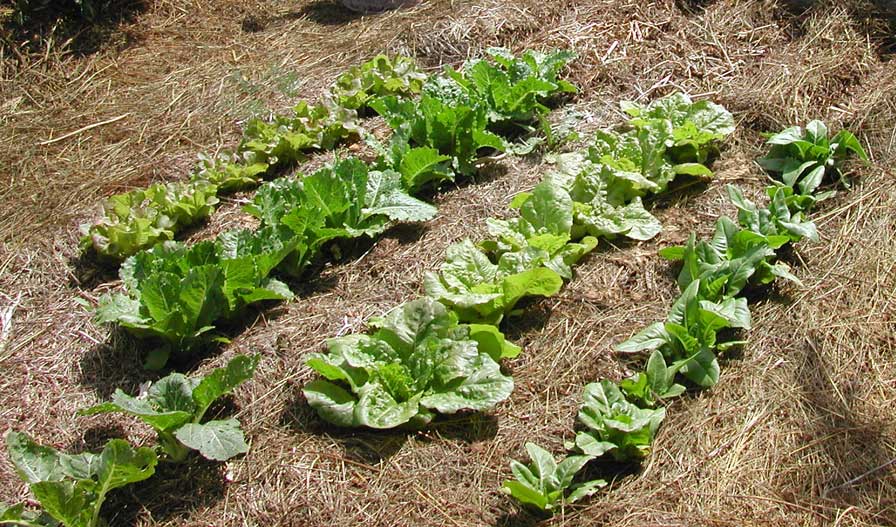 SALADS. Spring is salad time. It’s been a long, stored-food winter,
and those first few fresh-from-the-ground green leaves will never be so special.
So now is a good time to tackle your commitment. If you truly want to eat meals
from your garden and cut down on the amount of store bought packaged food coming
into your house, resolve to do it. Right now. And what a great place to start --
in the salad bowl. Now I’m not talking about a small bowl of anemic leaves
smothered with over salted over sugared bottled dressing. I’m talking about
something that fills that void in your stomach, not teases or terrorizes it. My
kind of salad is not boring. It is lively and ever changing. Good for lunch or
supper. Breakfast even, if you want.
SALADS. Spring is salad time. It’s been a long, stored-food winter,
and those first few fresh-from-the-ground green leaves will never be so special.
So now is a good time to tackle your commitment. If you truly want to eat meals
from your garden and cut down on the amount of store bought packaged food coming
into your house, resolve to do it. Right now. And what a great place to start --
in the salad bowl. Now I’m not talking about a small bowl of anemic leaves
smothered with over salted over sugared bottled dressing. I’m talking about
something that fills that void in your stomach, not teases or terrorizes it. My
kind of salad is not boring. It is lively and ever changing. Good for lunch or
supper. Breakfast even, if you want.
Don’t think too much about it. Just decide, yep, salad for dinner. Time to
go pick some greens. Grab a basket and go into your garden or greenhouse or cold
frame or yard or field. Wherever you might find edible leaves. Pick randomly
here and there. Early in the spring you probably won’t be able to get enough
material from just a few plants, so you’ll have to browse farther. If you can’t
find enough for a decent meal, pick what you can, then resolve to plant more and
earlier next year, and overwinter more plants next fall (in the garden, cold
frame, greenhouse, or sun-room). TIP for crispier lettuce - pick it in the
morning, wash if you need to and tap or twirl dry in a towel, wrap loosely in a
cloth and put it in your refrigerator or cold spot for using later in the day.
Growing season hasn’t even started yet for you? That’s OK. Get out those
seed catalogues. Order up some packets. Plant seeds with rash abandon, inside
and out. If, come summer, you have way too much green stuff growing, consider it
fodder for the compost pile. Then plant a little less next year. Make notes are
what you liked, what you didn't.
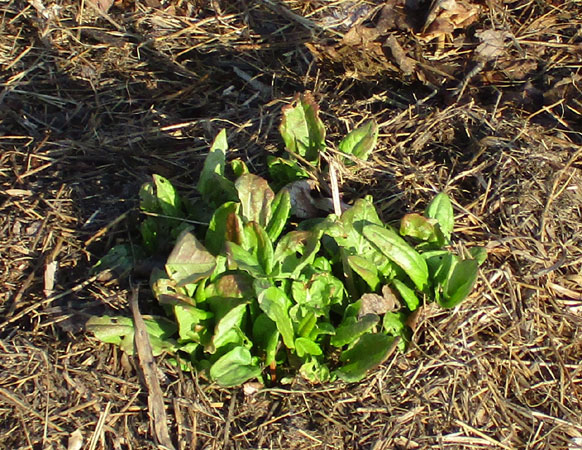 For my early spring salads, the perennial Garden Sorrel is the first to offer
edible leaves in the garden. And the Swiss Chard that was dug up and replanted
last fall into the greenhouse is busy growing new leaves along with its seed
stalk. Some may have overwintered and started re-growing. All sorts of greens can be started early inside. In March I may have
flats of hardy 'winter' lettuce, Pac Choy or Lettucy
Chinese cabbage, parsley or spinach. I transplant them outside to cold frames if
weather permits, or leave them to grow inside for early eating. Experiment for
yourself. Some of the other greens, such as Kyona Mizuna, will give you a much
longer harvest life. Choose the ones you find easiest to grow and harvest. Don’t
make an easy salad difficult. If you plant enough for spring, you’ll have an
abundance in early summer. Plant a variety of greens and you’ll have
leaves to eat all the growing season.
For my early spring salads, the perennial Garden Sorrel is the first to offer
edible leaves in the garden. And the Swiss Chard that was dug up and replanted
last fall into the greenhouse is busy growing new leaves along with its seed
stalk. Some may have overwintered and started re-growing. All sorts of greens can be started early inside. In March I may have
flats of hardy 'winter' lettuce, Pac Choy or Lettucy
Chinese cabbage, parsley or spinach. I transplant them outside to cold frames if
weather permits, or leave them to grow inside for early eating. Experiment for
yourself. Some of the other greens, such as Kyona Mizuna, will give you a much
longer harvest life. Choose the ones you find easiest to grow and harvest. Don’t
make an easy salad difficult. If you plant enough for spring, you’ll have an
abundance in early summer. Plant a variety of greens and you’ll have
leaves to eat all the growing season.
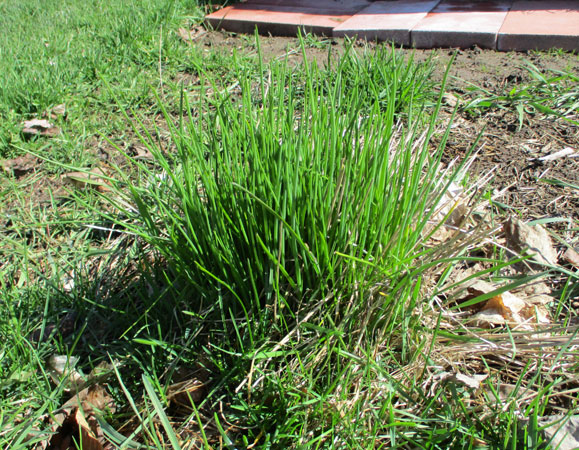 But back to today’s meal. Add to your basket whatever else you can find in
the garden. I know this sounds a little loose, but this salad is like that. What’s
edible? What’s mature? Asparagus (fresh or lightly steamed), overwintered
parsnips or carrots (shredded, diced), radishes, onions, chives. Later in the season there will be an
abundance of choices -- peas (snow, edible pod, or regular), snap beans,
cucumbers, broccoli, potatoes, etc. Either raw or steamed. Our salads change as
the season does.
But back to today’s meal. Add to your basket whatever else you can find in
the garden. I know this sounds a little loose, but this salad is like that. What’s
edible? What’s mature? Asparagus (fresh or lightly steamed), overwintered
parsnips or carrots (shredded, diced), radishes, onions, chives. Later in the season there will be an
abundance of choices -- peas (snow, edible pod, or regular), snap beans,
cucumbers, broccoli, potatoes, etc. Either raw or steamed. Our salads change as
the season does.
Back inside, briefly rinse the greens if necessary (mulched plants make this job
incidental) and spread them out between dish towels to dry. Wash, shred, chop
the other vegetables. Steam them briefly in a little water if you like.
Now round up any leftovers you may have. These give some bulk to a meal that
might be a little sparse in the "from the garden" section in early
spring. Don’t limit yourself here. Assume the leftovers will taste fine in the
salad. Require them to make a good case against it if they don’t want to go.
Not the other way around. Potatoes, pasta dishes, meat, beans, rice, fruit,
vegetables, cooked cereals -- there is a lot of leeway here. It is also a good
reason to cook extra the previous meal. Add whatever you have to the bowl.
If your salad is still a little on the lean side, then boil up some pasta.
Whole grain preferably -- might as well get as much nutrition as you can from
the food you eat. Besides it cooks faster. In fact, the key to successful whole
grain pasta is to NOT overcook it. We mostly use ww elbow macs because they are
quick, easy, and versatile. Noodles and tiny pastas are faster. Or couscous. Bring some water to boil. Just enough to generously
cover the amount of pasta you want to cook. Forget the common gallons-of-water
requirement which just wastes time, energy, and water, and isn’t necessary.
(Where did that come from anyway??). Add pasta and boil gently until just
past the paste stage -- past chewy but not done. Turn off heat and leave covered
to finish cooking. Which doesn’t take very long. Drain water when pasta is the
texture you like. Wait too long and it will become mushy. You’ll want a nice
firm pasta for salads. Broken up spaghetti is also good.
You can, of course, also use canned or reconstituted dried vegetables. I
particularly like cooked dried beans, for texture and food value. Or green peas
or snap beans. Drain and add.
Tear up your greens and let them join the party.
If you end up with more than you need just save leftovers for the next
meal.
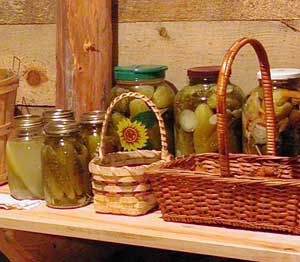 Garnishes and additions -- there is a wide range of possibilities here --
cheese, fruit (I like raisins), nuts, sunflower seeds, homemade croutons, chopped parsley, cooked
eggs, pickles. A few edible flowers make an interesting garnish, particularly
for potlucks (violets or Johnny Jump Ups are what I usually use). Adds some
interest.
Garnishes and additions -- there is a wide range of possibilities here --
cheese, fruit (I like raisins), nuts, sunflower seeds, homemade croutons, chopped parsley, cooked
eggs, pickles. A few edible flowers make an interesting garnish, particularly
for potlucks (violets or Johnny Jump Ups are what I usually use). Adds some
interest.
Now for the dressing.
If you like oil add it a spoonful at a time until it just touches all
the ingredients without over coating. You want to barely notice the oil, not
slip around in it. A high quality olive oil is nice for this, but any vegetable
oil will do. I usually skip the oil since it makes cleanup easier and we don't
miss it.
Herbed vinegar is nice. If you have
some good homemade
vinegar this is where it can show off. If not, any good tasting vinegar will do.
Add an array of dried, crushed herbs to it. I use whatever I have - basil, oregano, sage, thyme. Maybe a little salt and ground peppers. A
dash of maple syrup or honey. A little wine if you like. Mustard? Some water if
the vinegar is too strong. Whatever suits your fancy to
give a bit of flavor. Shake well.
Instead of vinegar I
usually add the pickle juice from my home-made Sweet-Sour
Spiced Pickles (when the pickles are gone). Often this is the dressing itself
with no other additions.
Add your dressing to the salad a spoonful at a time, mixing well and
tasting before adding more. It’s easy to drown the salad in vinegar if you
just dump it on. A salad heavy on potatoes or rice will take more; heavy on
greens will take less.
You can also add your oil to the herbed vinegar bottle, shaking well before
dispensing it all together onto the salad. Mine seemed to always come out oil
first, no matter how long and vigorously I shook it which is why I do it
in two steps or not at all. Any number of salad dressings can be purchased or made to suit
your fancy. I just find my homemade to be easy and versatile. It lasts well so
you can make a large batch.
Now, slice some bread or cornbread for the side, and your meal is ready. You can
have this salad every day all year and never have the same meal twice. In
mid-winter, when things are hanging out in the greenhouse but not growing, the
greens are spread pretty thin here, often being only some chopped parsley (which
manages to be perky and edible even during the coldest winters when the
greenhouse goes below freezing). But we sure do appreciate
whatever green stuff I can harvest. And REALLY appreciate spring when the green
things start growing again.
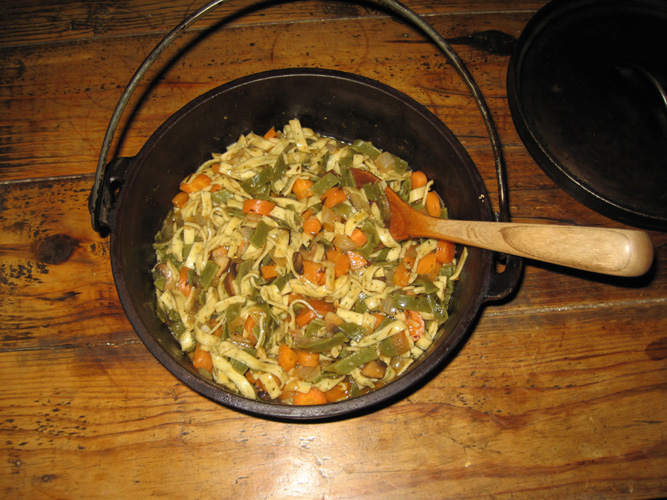 On to the SAUTE’s. For me this meal always starts the same. I don’t
have to think about it. Off to the garden (or the pantry or root cellar) with the venerable harvest basket.
(For fun get one you like from a local basket-maker. You’ll be using it a lot and it
will feel good.) What do you have? What’s big enough to harvest? What catches your eye? What
sounds good? Have fun with it. So, what do you have?
Asparagus? Broccoli? Squash? One vegetable is fine, usually several is nice. I
start with onions and garlic then go from there. Potatoes and carrots are
regulars, others are additions. Almost always spinach.
On to the SAUTE’s. For me this meal always starts the same. I don’t
have to think about it. Off to the garden (or the pantry or root cellar) with the venerable harvest basket.
(For fun get one you like from a local basket-maker. You’ll be using it a lot and it
will feel good.) What do you have? What’s big enough to harvest? What catches your eye? What
sounds good? Have fun with it. So, what do you have?
Asparagus? Broccoli? Squash? One vegetable is fine, usually several is nice. I
start with onions and garlic then go from there. Potatoes and carrots are
regulars, others are additions. Almost always spinach.
Back inside, wash the vegetables, and cut to edible size. Heat some oil, just
hot enough to gently sizzle when the vegetables are added but not so hot they
jump and yell. Sprinkle in one or another dried herb, whatever comes to hand. Or
you can keep a small bottle of oil laced with dried herbs and use that. This
mixture really lets loose some heady aromas when heated, especially if it has a
lot of sage in it. Add garlic then onions and stir around a bit.
Instant chefdom. Just writing about it makes my nose twitch and my mouth water.
No matter what comes next those in the house will assume it will be good just
from that smell (this is assuming you and/or they like garlic and onions!)
Now add the
firmer chopped vegetables, then the softer. Don’t get too worried about what
goes in when and for how long, you’ll get the idea from experience and what you
like. Generally, it's root crops first, the firm veggies (like snap beans).
Later the soft veggies (like greens) are added. Stir them around a bit letting
them all get a chance at the hot oil.
Then add some
liquid, usually water but most any broth will do. Use
just enough to cover the pan bottom but not the vegetables. You want to steam
the meal, not boil it. In fact, you can just steam everything and not bother
with the earlier sauteing in oil part. Cover and simmer until just right. What’s
right? Well, that depends. (This is why I’ll never be a cookbook author).
Taste often and stop cooking when you like the texture and taste of the
vegetables you’re cooking. I like them just past raw but not even close to
mushy. Suit your fancy.
You can add gravy stuff if you want, of course, but don’t be afraid to just
let this dish stand on its own. Add a little salt maybe, a little pepper. If the
main ingredient is potatoes, I like to add chopped pickles. Cheese is popular,
but don’t overdo it. It’s insulting to the vegetables, and you do want your
vegetables to be happy. If you want cheese with the meal, consider having it on
the side instead of on top.
Any type of grain can accompany this meal, cooked whole (rice, wheat, hulled
barley), or bread (whole wheat, cornbread, flat bread). Any leftovers usually
find their way into this dinner dish.
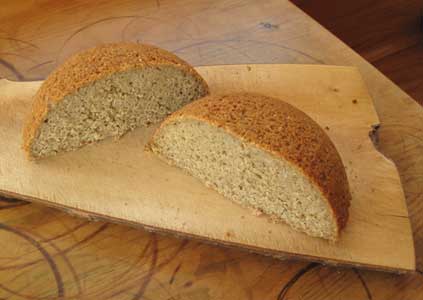 TIP
- Something that will make your life a lot easier and more fun is to get a good
cutting board of the size(s) you like. Two of mine are simply pieces of hardwood
boards (a small yellow birch and larger cherry), the third was split from a
crotch of an apple then planed flat. If you don't have a supply of odds and ends
of board around a visit to a local cabinet or furniture maker, or other
craftsman using hardwood, will likely find you good, inexpensive options. Or
even the lumberyard. The next is important - a very sharp comfortable good knife
It may not be inexpensive but it is essential. You will be doing a lot of
chopping! It would be well worth your while to learn to sharpen it yourself and
to keep it sharp. Not only will it be much easier to use it will be much safer.
TIP
- Something that will make your life a lot easier and more fun is to get a good
cutting board of the size(s) you like. Two of mine are simply pieces of hardwood
boards (a small yellow birch and larger cherry), the third was split from a
crotch of an apple then planed flat. If you don't have a supply of odds and ends
of board around a visit to a local cabinet or furniture maker, or other
craftsman using hardwood, will likely find you good, inexpensive options. Or
even the lumberyard. The next is important - a very sharp comfortable good knife
It may not be inexpensive but it is essential. You will be doing a lot of
chopping! It would be well worth your while to learn to sharpen it yourself and
to keep it sharp. Not only will it be much easier to use it will be much safer.
SOUP. Same as above only add more liquid. Usually served with some kind of
breadstuff or cracker on the side. Good rebirth for leftovers, or if you
overcooked your vegetables. Standard winter fare, also nice served on the colder spring and summer days. It
lifts the spirit when one wakes up to 17 degrees in the middle of July. For
ingredients, use whatever didn’t get wiped out by the freeze. There’s sure
to be something. Makes you appreciate the easier growing years.
SANDWICHES. Sandwich materials seldom come straight from the garden.
Though they can. Late in the summer I relish a tomato/cucumber/onion/lettuce
sandwich. But around here, sandwich usually means peanut butter and jam. On
whole wheat bread. Not exactly your Eat-Out-of-the-Garden poster child. But,
there are times when even the rather quick meals above take too much time. So when the entire family is immersed in some homestead
project that has to be done yesterday, and there’s no one to cook a meal,
sandwiches suffice. You can be more creative than just PB&J. Anything not
too soupy can go on a sandwich. Mashed leftover beans and rice with chopped
onion and mustard is good. With lettuce from the garden, of course. Peanut
butter, pickle, and lettuce also hits the spot some days. Go ahead and be
creative.
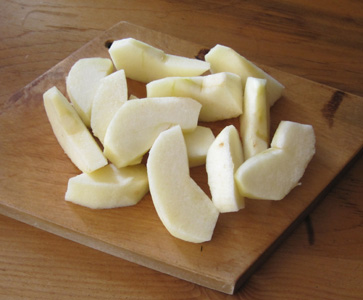 SNACKS. Grow a lot of carrots (if you or anyone in the family likes
carrots). Get in the habit of pulling a few whenever you’re in the garden.
Having a bowl of cut up carrots on the table helps keep the munchy monster from
making you head for something less healthy. (It also helps to not let anything
less healthy into the house, or at least not readily available.) Keep the carrots
barely covered with fresh water and they’ll taste enticingly crisp for days.
The same is true for many vegetable you or anyone in the family likes raw. Fruit
is a great snack, too. When apples are in season there are always slices of
apples on our table.
SNACKS. Grow a lot of carrots (if you or anyone in the family likes
carrots). Get in the habit of pulling a few whenever you’re in the garden.
Having a bowl of cut up carrots on the table helps keep the munchy monster from
making you head for something less healthy. (It also helps to not let anything
less healthy into the house, or at least not readily available.) Keep the carrots
barely covered with fresh water and they’ll taste enticingly crisp for days.
The same is true for many vegetable you or anyone in the family likes raw. Fruit
is a great snack, too. When apples are in season there are always slices of
apples on our table.
And speaking of fruit-- STRAWBERRIES. This is a crop that will need
little urging for many, if not most, people. If you don’t have time or
inclination to take care of a large plot, grow a small patch. Forget baking and
freezing and preserving. What better reward for getting into your garden to pick
dinner than a handful of ripe, fresh, juicy strawberries? If there are any left
after you are through rewarding yourself, bring a small basket of them in for
desert or between-meal snack. You don’t need a heaping bowl-full. If you only
have a few, serve a few. Such simple elegance doesn’t need quantity. Quality
will well suffice.
Or raspberries or blueberries or cherries or apples or plums. Let your
raspberry bushes spread with abandon along a fence, then let them grow and
produce without interference from you. Plant blueberries along the woods, or
simply make use of those already there. Plant fruit trees in your yard, north of
the garden, or east of the woodlot. Fruit. One of the easier
eat-from-the-garden, no-fuss-to-prepare, crops. Maybe it doesn’t start with an
‘S’, but satisfaction does, so that will do.
And rhubarb. I almost forgot the rhubarb. Prince of Spring, Queen of
the North. One of the easier breakfasts, too. Rhubarb sauce mixed with rolled
oats, sweetening (OK, lots of sweetening), maybe a few raisins, sunflower seeds. Sure to get you going
into your day with renewed vigor.
Eating in season out of the garden doesn’t have to take much time. It does
takes wanting, and willingness. Simply make it a habit. Once you start, you can
continue all year long. The meals may change with the seasons, but the good food
doesn’t have to.
Need another
incentive? Unplug your refrigerator, give away your freezer. No, I’m not
kidding. It will help you see your food source in a different way. Find or make a cool room or spot for temporary holdover of
vegetables and leftovers. Then when you want something to eat, head out to your
garden or pantry or root cellar. You’ll find everything you need right
there.
Wishing you good,
happy eating. From your garden, from your community,
from the Earth.


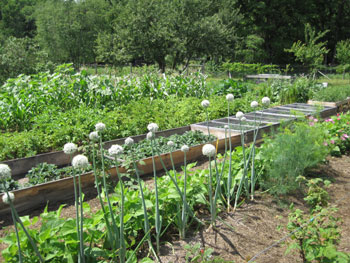
 SALADS. Spring is salad time. It’s been a long, stored-food winter,
and those first few fresh-from-the-ground green leaves will never be so special.
So now is a good time to tackle your commitment. If you truly want to eat meals
from your garden and cut down on the amount of store bought packaged food coming
into your house, resolve to do it. Right now. And what a great place to start --
in the salad bowl. Now I’m not talking about a small bowl of anemic leaves
smothered with over salted over sugared bottled dressing. I’m talking about
something that fills that void in your stomach, not teases or terrorizes it. My
kind of salad is not boring. It is lively and ever changing. Good for lunch or
supper. Breakfast even, if you want.
SALADS. Spring is salad time. It’s been a long, stored-food winter,
and those first few fresh-from-the-ground green leaves will never be so special.
So now is a good time to tackle your commitment. If you truly want to eat meals
from your garden and cut down on the amount of store bought packaged food coming
into your house, resolve to do it. Right now. And what a great place to start --
in the salad bowl. Now I’m not talking about a small bowl of anemic leaves
smothered with over salted over sugared bottled dressing. I’m talking about
something that fills that void in your stomach, not teases or terrorizes it. My
kind of salad is not boring. It is lively and ever changing. Good for lunch or
supper. Breakfast even, if you want. For my early spring salads, the perennial Garden Sorrel is the first to offer
edible leaves in the garden. And the Swiss Chard that was dug up and replanted
last fall into the greenhouse is busy growing new leaves along with its seed
stalk. Some may have overwintered and started re-growing. All sorts of greens can be started early inside. In March I may have
flats of hardy 'winter' lettuce, Pac Choy or Lettucy
Chinese cabbage, parsley or spinach. I transplant them outside to cold frames if
weather permits, or leave them to grow inside for early eating. Experiment for
yourself. Some of the other greens, such as Kyona Mizuna, will give you a much
longer harvest life. Choose the ones you find easiest to grow and harvest. Don’t
make an easy salad difficult. If you plant enough for spring, you’ll have an
abundance in early summer. Plant a variety of greens and you’ll have
leaves to eat all the growing season.
For my early spring salads, the perennial Garden Sorrel is the first to offer
edible leaves in the garden. And the Swiss Chard that was dug up and replanted
last fall into the greenhouse is busy growing new leaves along with its seed
stalk. Some may have overwintered and started re-growing. All sorts of greens can be started early inside. In March I may have
flats of hardy 'winter' lettuce, Pac Choy or Lettucy
Chinese cabbage, parsley or spinach. I transplant them outside to cold frames if
weather permits, or leave them to grow inside for early eating. Experiment for
yourself. Some of the other greens, such as Kyona Mizuna, will give you a much
longer harvest life. Choose the ones you find easiest to grow and harvest. Don’t
make an easy salad difficult. If you plant enough for spring, you’ll have an
abundance in early summer. Plant a variety of greens and you’ll have
leaves to eat all the growing season. But back to today’s meal. Add to your basket whatever else you can find in
the garden. I know this sounds a little loose, but this salad is like that. What’s
edible? What’s mature? Asparagus (fresh or lightly steamed), overwintered
parsnips or carrots (shredded, diced), radishes, onions, chives. Later in the season there will be an
abundance of choices -- peas (snow, edible pod, or regular), snap beans,
cucumbers, broccoli, potatoes, etc. Either raw or steamed. Our salads change as
the season does.
But back to today’s meal. Add to your basket whatever else you can find in
the garden. I know this sounds a little loose, but this salad is like that. What’s
edible? What’s mature? Asparagus (fresh or lightly steamed), overwintered
parsnips or carrots (shredded, diced), radishes, onions, chives. Later in the season there will be an
abundance of choices -- peas (snow, edible pod, or regular), snap beans,
cucumbers, broccoli, potatoes, etc. Either raw or steamed. Our salads change as
the season does. Garnishes and additions -- there is a wide range of possibilities here --
cheese, fruit (I like raisins), nuts, sunflower seeds, homemade croutons, chopped parsley, cooked
eggs, pickles. A few edible flowers make an interesting garnish, particularly
for potlucks (violets or Johnny Jump Ups are what I usually use). Adds some
interest.
Garnishes and additions -- there is a wide range of possibilities here --
cheese, fruit (I like raisins), nuts, sunflower seeds, homemade croutons, chopped parsley, cooked
eggs, pickles. A few edible flowers make an interesting garnish, particularly
for potlucks (violets or Johnny Jump Ups are what I usually use). Adds some
interest. On to the SAUTE’s. For me this meal always starts the same. I don’t
have to think about it. Off to the garden (or the pantry or root cellar) with the venerable harvest basket.
(For fun get one you like from a local basket-maker. You’ll be using it a lot and it
will feel good.) What do you have? What’s big enough to harvest? What catches your eye? What
sounds good? Have fun with it. So, what do you have?
Asparagus? Broccoli? Squash? One vegetable is fine, usually several is nice. I
start with onions and garlic then go from there. Potatoes and carrots are
regulars, others are additions. Almost always spinach.
On to the SAUTE’s. For me this meal always starts the same. I don’t
have to think about it. Off to the garden (or the pantry or root cellar) with the venerable harvest basket.
(For fun get one you like from a local basket-maker. You’ll be using it a lot and it
will feel good.) What do you have? What’s big enough to harvest? What catches your eye? What
sounds good? Have fun with it. So, what do you have?
Asparagus? Broccoli? Squash? One vegetable is fine, usually several is nice. I
start with onions and garlic then go from there. Potatoes and carrots are
regulars, others are additions. Almost always spinach.  TIP
- Something that will make your life a lot easier and more fun is to get a good
cutting board of the size(s) you like. Two of mine are simply pieces of hardwood
boards (a small yellow birch and larger cherry), the third was split from a
crotch of an apple then planed flat. If you don't have a supply of odds and ends
of board around a visit to a local cabinet or furniture maker, or other
craftsman using hardwood, will likely find you good, inexpensive options. Or
even the lumberyard. The next is important - a very sharp comfortable good knife
It may not be inexpensive but it is essential. You will be doing a lot of
chopping! It would be well worth your while to learn to sharpen it yourself and
to keep it sharp. Not only will it be much easier to use it will be much safer.
TIP
- Something that will make your life a lot easier and more fun is to get a good
cutting board of the size(s) you like. Two of mine are simply pieces of hardwood
boards (a small yellow birch and larger cherry), the third was split from a
crotch of an apple then planed flat. If you don't have a supply of odds and ends
of board around a visit to a local cabinet or furniture maker, or other
craftsman using hardwood, will likely find you good, inexpensive options. Or
even the lumberyard. The next is important - a very sharp comfortable good knife
It may not be inexpensive but it is essential. You will be doing a lot of
chopping! It would be well worth your while to learn to sharpen it yourself and
to keep it sharp. Not only will it be much easier to use it will be much safer. SNACKS. Grow a lot of carrots (if you or anyone in the family likes
carrots). Get in the habit of pulling a few whenever you’re in the garden.
Having a bowl of cut up carrots on the table helps keep the munchy monster from
making you head for something less healthy. (It also helps to not let anything
less healthy into the house, or at least not readily available.) Keep the carrots
barely covered with fresh water and they’ll taste enticingly crisp for days.
The same is true for many vegetable you or anyone in the family likes raw. Fruit
is a great snack, too. When apples are in season there are always slices of
apples on our table.
SNACKS. Grow a lot of carrots (if you or anyone in the family likes
carrots). Get in the habit of pulling a few whenever you’re in the garden.
Having a bowl of cut up carrots on the table helps keep the munchy monster from
making you head for something less healthy. (It also helps to not let anything
less healthy into the house, or at least not readily available.) Keep the carrots
barely covered with fresh water and they’ll taste enticingly crisp for days.
The same is true for many vegetable you or anyone in the family likes raw. Fruit
is a great snack, too. When apples are in season there are always slices of
apples on our table.